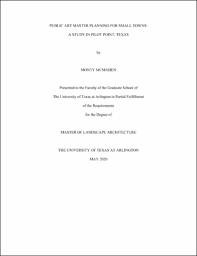
ATTENTION: The works hosted here are being migrated to a new repository that will consolidate resources, improve discoverability, and better show UTA's research impact on the global community. We will update authors as the migration progresses. Please see MavMatrix for more information.
Show simple item record
| dc.contributor.advisor | Allen, Diane Jones | |
| dc.creator | McMahen, Monty | |
| dc.date.accessioned | 2020-06-15T13:42:30Z | |
| dc.date.available | 2020-06-15T13:42:30Z | |
| dc.date.created | 2020-05 | |
| dc.date.issued | 2020-05-14 | |
| dc.date.submitted | May 2020 | |
| dc.identifier.uri | http://hdl.handle.net/10106/29122 | |
| dc.description.abstract | This design thesis explores the development of a public art master plan as a tool for small towns to address issues and opportunities in their communities. This exploration was undertaken through the study and design of a proposed public art master plan for the small town of Pilot Point, Texas. A public art master plan can empower communities to embrace art as a unique and vital resource to help shape and reflect the community’s cultural identity while leveraging the arts for economic development and other benefits that enhance quality of life (Markusen & Gadwa, 2010). While public art master plans are more common in larger cities with population over 100,000, dedicated planning staff, and large capital expenditure programs, this study demonstrates that small towns can utilize this tool to the benefit of their communities (American for the Arts, 2017).
A multimethod research approach was employed in this thesis. (Sommer & Sommer, 2002). A literature review on the history, benefits, and other aspect of public art master plans is discussed. Next a review of comparable arts master plans is conducted to understand generally accepted components, strategies, and objectives. Data was collected and documented through an engagement and study with the town of Pilot Point, Texas, to design and create a proposed public art master plan. This study consisted of a series of meetings, community engagement events, and a data collection questionnaire. Finally, interviews with landscape architect experts were conducted to gather expert data on public art master planning with an emphasis on addressing issues facing small towns and opportunities that might be unique to small towns.
The analysis and findings from the research were used to inform the design of a proposed public art master plan for the city of Pilot Point. Through engagement with the community, goals and strategies were developed to utilize public art in order to address identified current and potential future issues with an eye towards improving the overall experience of living in and visiting the town. For example, Pilot Point is proud of its history and the quality of life they have developed and are hopeful that by creating a public art cultural framework as part of the public art master plan, future works of art can help capture and convey these feelings to an expanding population, and add to the sense of place cultivated by the community. This study documents the process on how to develop a public art master plan with the intent that other small towns can apply this process to their own site-specific set of issues and opportunities in order to embrace art as a means to achieve beneficial goals that enhance the livability and attractiveness of their communities. | |
| dc.format.mimetype | application/pdf | |
| dc.language.iso | en_US | |
| dc.subject | Public Art | |
| dc.subject | Landscape architecture | |
| dc.title | Public Art Master Planning for Small Towns: A Study in Pilot Point, Texas | |
| dc.type | Thesis | |
| dc.contributor.committeeMember | Allen, Diane Jones | |
| dc.degree.department | Landscape Architecture | |
| dc.degree.name | Master of Landscape Architecture | |
| dc.date.updated | 2020-06-15T13:42:30Z | |
| thesis.degree.department | Landscape Architecture | |
| thesis.degree.grantor | The University of Texas at Arlington | |
| thesis.degree.level | Masters | |
| thesis.degree.name | Master of Landscape Architecture | |
| dc.type.material | text | |
| dc.creator.orcid | 0000-0003-0675-3305 | |
Files in this item
- Name:
- MCMAHEN-THESIS-2020.pdf
- Size:
- 34.77Mb
- Format:
- PDF
This item appears in the following Collection(s)
Show simple item record


